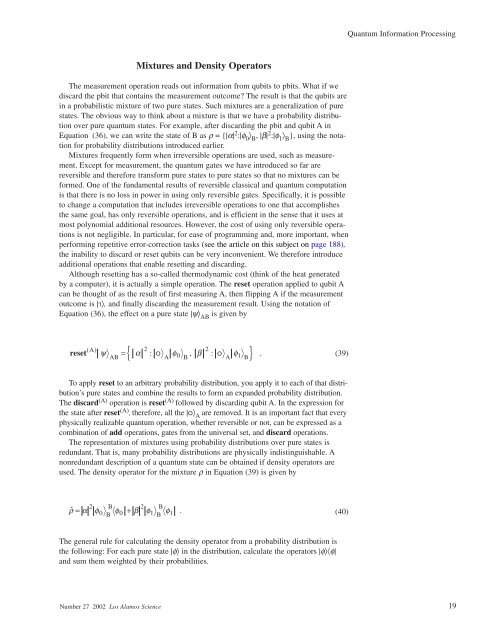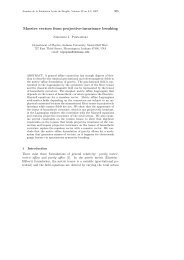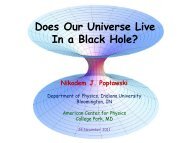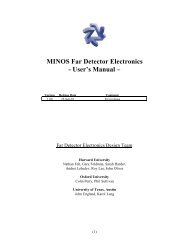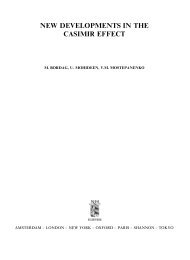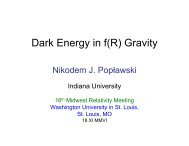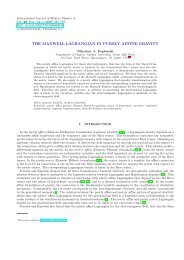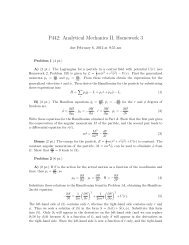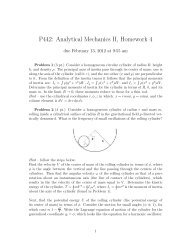Quantum Information Processing
Quantum Information Processing
Quantum Information Processing
Create successful ePaper yourself
Turn your PDF publications into a flip-book with our unique Google optimized e-Paper software.
Mixtures and Density Operators<br />
The measurement operation reads out information from qubits to pbits. What if we<br />
discard the pbit that contains the measurement outcome? The result is that the qubits are<br />
in a probabilistic mixture of two pure states. Such mixtures are a generalization of pure<br />
states. The obvious way to think about a mixture is that we have a probability distribution<br />
over pure quantum states. For example, after discarding the pbit and qubit A in<br />
Equation (36), we can write the state of B as ρ = {|α| 2 :|φ 0 〉 B , |β| 2 :|φ 1 〉 B }, using the notation<br />
for probability distributions introduced earlier.<br />
Mixtures frequently form when irreversible operations are used, such as measurement.<br />
Except for measurement, the quantum gates we have introduced so far are<br />
reversible and therefore transform pure states to pure states so that no mixtures can be<br />
formed. One of the fundamental results of reversible classical and quantum computation<br />
is that there is no loss in power in using only reversible gates. Specifically, it is possible<br />
to change a computation that includes irreversible operations to one that accomplishes<br />
the same goal, has only reversible operations, and is efficient in the sense that it uses at<br />
most polynomial additional resources. However, the cost of using only reversible operations<br />
is not negligible. In particular, for ease of programming and, more important, when<br />
performing repetitive error-correction tasks (see the article on this subject on page 188),<br />
the inability to discard or reset qubits can be very inconvenient. We therefore introduce<br />
additional operations that enable resetting and discarding.<br />
Although resetting has a so-called thermodynamic cost (think of the heat generated<br />
by a computer), it is actually a simple operation. The reset operation applied to qubit A<br />
can be thought of as the result of first measuring A, then flipping A if the measurement<br />
outcome is |〉, and finally discarding the measurement result. Using the notation of<br />
Equation (36), the effect on a pure state |ψ〉 AB is given by<br />
reset<br />
( A)<br />
2<br />
2<br />
AB A 0 B A 1 B<br />
ψ α : φ , β : φ .<br />
To apply reset to an arbitrary probability distribution, you apply it to each of that distribution’s<br />
pure states and combine the results to form an expanded probability distribution.<br />
The discard (A) operation is reset (A) followed by discarding qubit A. In the expression for<br />
the state after reset (A) , therefore, all the |〉 A are removed. It is an important fact that every<br />
physically realizable quantum operation, whether reversible or not, can be expressed as a<br />
combination of add operations, gates from the universal set, and discard operations.<br />
The representation of mixtures using probability distributions over pure states is<br />
redundant. That is, many probability distributions are physically indistinguishable. A<br />
nonredundant description of a quantum state can be obtained if density operators are<br />
used. The density operator for the mixture ρ in Equation (39) is given by<br />
2 B 2 B<br />
ˆ ρ = α φ0 φ0+ β φ1 φ<br />
B<br />
B 1<br />
= { }<br />
.<br />
The general rule for calculating the density operator from a probability distribution is<br />
the following: For each pure state |φ〉 in the distribution, calculate the operators |φ〉〈φ|<br />
and sum them weighted by their probabilities.<br />
Number 27 2002 Los Alamos Science 19<br />
(39)<br />
(40)<br />
<strong>Quantum</strong> <strong>Information</strong> <strong>Processing</strong>


